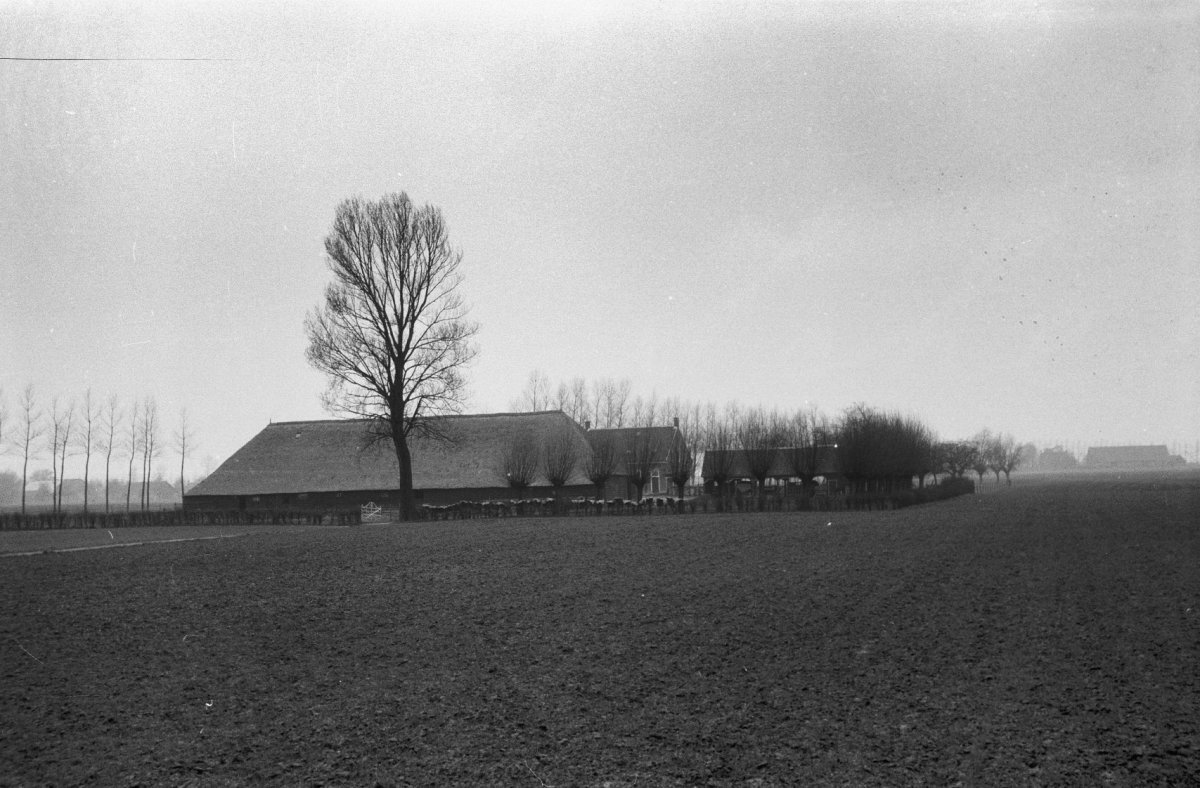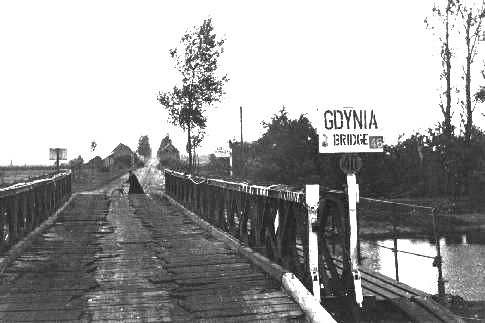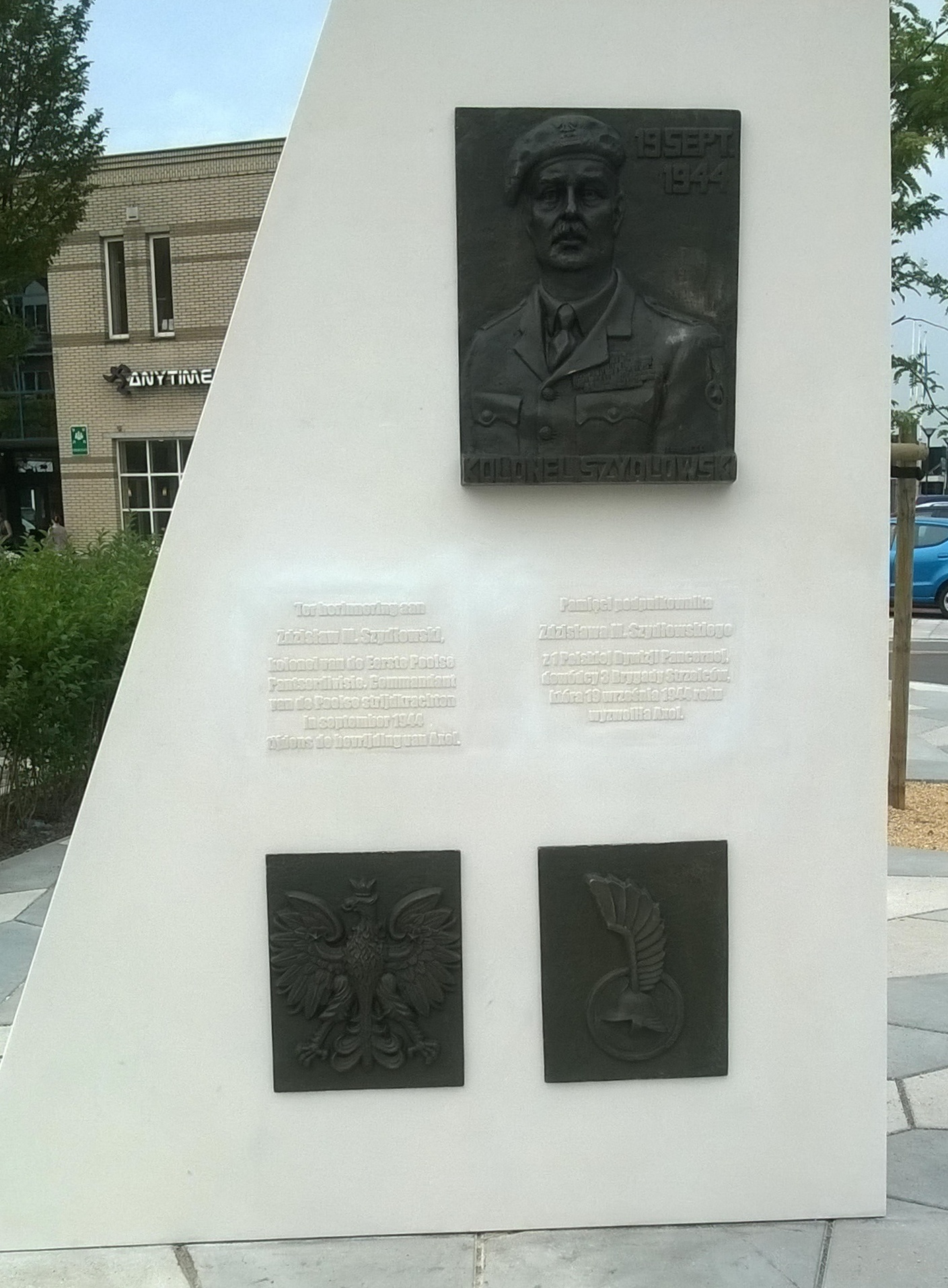There is a story of the battle of Axel which is not well-known by the Poles but it was very important for liberation of the Netherlands. We present our thanks to Mr. Tomasz Sawicki, who wrote it, as it is definitely worth publishing indeed to commemorate all those brave young soldiers who died in this battle.
Introduction
Axel – a town in the south-west of the Dutch province of Zeeland, is situated only 6 km from the Belgian border. It has currently slightly over 8 000 people resides. The greatest development had place in the Middle Ages, when Axel became trade and port center. In 2013 the town celebrated the millenary of obtaining the city rights.
Axel, view on the south, from the windmill from the Molenstreet (photo archiv.)
Today it plays mainly a role as residential facilities for the industrial port Terneuzen, which is also the seat of the municipality. As it is known, Zeeland is a land which has been for many centuries extorted by Dutch from the sea, and beeing not aware of it, one won’t understand that Axel was once a port which was connected to the sea through the estuary of the river Scheldt. Today the Scheldt lets seagoing ships sail up to Antwerp (about 50 km inland) – one of the largest ports serving current container traffic in Western Europe.
Estuary of the Scheldt
World War II – the background of the battle of Axel
For a better understanding of the role of Axel in the liberation of the Netherlands it is necessary to mention the Allied invasion “Operation Overlord”. This famous invasion, has no equal counterpart in of the military history and began on June 6th, 1944 with attacks of the naval and air forces on the Normandy beaches. Sections of them, having the innocent-sounding code names of: Omaha, Utah, Gold, Juno and Word, became a place of the biggest battle of World War II. Unfortunately the Germans were prepared for it as they were not mislead by Allied disinformation. Unluckily for Allies the coast was protected not only by huge bunkers and heavy artillery but also by its natural ally – high and hard-to-reach sea cliffs. The infantry that landed on the coastal shallows, was massively killed under machine-guns and mortar fire. Those who had survived this massacre climbed upon the cliffs and took the German bunkers, opening the way for their comrades. The same happened in the area of Caen, and Falaise.
A powerful strike forced Germans to regroup their troops to the east, towards the borders of Belgium and the Netherlands. During that action they managed however to organize strong points of resistance. Meanwhile Allied offensive resulted in increasing demands for logistics services as routes for equipments, weapons, food and soldiers so the supplylines became longer and longer. This situation forced Commander General Dwight Eisenhower to order the breaking of the German resistance in the estuary of the Scheldt to enable war supply vessels to use the Belgium ports of Antwerp, Ghent and Terneuzen. This was important because the freight from the large ships had to be reloaded into barges and pontoons in deep water, after that it was transferred to the shore and further by trucks to the front line.
Unloading the Sherman tanks Firefly Mk VC belonging to the 1.Pułku Armoured at the artificial Mulberry B port, Normandy, July 1944
It is obvious the stormy weather slowed down or even made this transfer impossible and sometimes caused big losses. This is how the plan of the operation in the lower Scheldt area was born. It included four operating regions referred to as the “islands” Axel, Breskens, Walcheren and Beveland.
The battle and liberation of Axel
The mission of getting Axel had been commissioned by General Guy Simonds, the Commander of the 1st Canadian Army that included the 1st Polish Armoured Division. The task was realized by the brigade under the command of Colonel. Dipl. Franciszek Skibiński during five days of hard battles (September 16-20, 1944).
Colonel Franciszek Skibiński (right) and General Stanisław Maczek (left), 1944
It is worth noting that Polish soldiers hadn’t been supported at all by allied air forces or artillery. That happened probably because at the same time in the area of Arnhem the great operation “Market – Garden” took place, following the big ambition of Marshal Bernard Montgomery, what unfortunately led to the bloody defeat of the Allies. (A bridge to far).
The operation in the Axel area had its dramatic turns and breaking the defense of the well prepared 712 Infantry Division of the Wehrmacht was not an easy task. It must be known that this countryside has its specific features – open, flat fields and meadows that could be easily turned into wetlands, the nightmares for tanks and armored vehicles. This specificity of the Dutch battlefields favored defenders better than the attacking infantry shielded by tanks. For those reasons tanks could move almost only on roads built on dikes and embankments. It is easy to imagine how severe a damaged or destroyed vehicle hampered the traffic or any combat operation. For transferring tanks over channels very often were bridges necessary, and those ones which were destroyed by the Germans had to be replaced by temporary structures with a capacity of at least 30 tons, to be built by Polish sappers. One of such temporary bridges the Poles started to build on September 17th near the farme of the family Du Bosch. In the pictures below: archival and contemporary photo of the farm.
Picture: “Odwach” Association, 2018 (see also: On the Polish Dragoon trail)
Unfortunately this operation was discovered by the German observers located on the watertower in Axel while it still was kept by Nazis. An very accurate artillery bombardment from that tower, 50 meters high above the open terrain, led to a massacre of the Poles. 25 of the young soldiers were killed and a very large amount of military equipment had been smashed. This tragic event is commemorated by a monument in the shape of a cross, built of remains of the “Polish” bridge and marked with appropriate commemorative plaque.
The Dragoon Cross, on the place were 25 Polish soldiers died
The importance of this passage was proved by the fact that in the next night, less than a mile away, an identical bridge was erected, thanks to the Polish Podhale Riflemen who managed to take the outpost on the other side of the channel. It allowed attacking Axel. The crossing point through the channel Axel-Hulst got a tactical name “Gdynia Bridge”.
The famous Gdynia Bridge
Colonel Franciszek Skibiński who was the commander over this operation, described it in a detailed way, considering general situation of the front, in his book entitled “Axel”. Axel was captured on September 19th by soldiers commanded by Lt.-Col. Zdzislaw Szydłowski in a bold attack flanking the city what minimized civilian casualties. Here is a quote of a part of his book:
“At noon on September 19th the companies of Flemish riflemen, supported directly and effectively by tanks, entered the city and conquered it in the short-term street battle, taking 80 prisoners, 7 antitank guns and 4 mortars, not mentioning the machine guns. Regardless the last bullets still whistling over the roofs, growing crowds of people hatched the streets of freshly liberated Axel.”
Axel citizens and a Polish liberator from 1st Polish Armoured Division
The end of the fight, what means liberating the other “islands”, took place only on November 8th. The casualties of the 1st Canadian Army amounted to about 13,000 killed, wounded and missing. It has to be remembered that this operation was started victoriously by the Poles who fulfilled the mission with no support, forcing Germans to escape through the river Scheldt to the Walcheren island.
There is an interesting fact. In this area the difference in water levels between high tide and outflow is over 3.5 metres. The Germans evacuating themselves on the floating equipment were highly surprised with the outflow and got stuck on a sandbank, becoming an easy target for Polish squadron of Shermans, patrolling embankment.

Polish Shermans
Only the luckiest Nazi soldiers managed to escape by swimming to the other side. According to the testimony of later prisoners, their commander, General Neuman, probably did not survive the crossing [gen. Friedrich Wilhelm Neumann survived it and died in 1975. What is interesting, he was a participant of September 1939 invasion on Poland so it was a kind of Polish revenge – Hbt].
A summary of the operation
According to Franciszek Skibiński, in fierce struggles of Ghent and the “island of Axel” the Poles imprisoned 1173 Germans, including 19 officers (not mentioning the number of the dead and wounded Nazis).
More important military equipment captured by Polish soldiers:
- 4 rail guns 210 mm
- 2 guns 88 mm
- 12 guns 75 mm
- 16 anti-tank guns 50 mm
- 6 mortars 81 mm
Total – 40 barrels, enough to arm an artillery brigade!
Own losses:
- 75 killed – including 6 officers
- 191 injured – including 12 officers
- 63 missing
Those numbers say much about contribution of the “black devils” – as the soldiers of General Stanislaw Maczek were called – in the victory over fascism. Although 70 years have passed since those grim events but concrete bunkers, silent witnesses of the war history, still exist in the fields of the province of Zeeland. Sometimes plowing excavates rusty fragments of war remains from the earth.
Epilogue
During those 70 years the memory of those events is consistently alive in the collective consciousness of the community Axel. The names of the streets, monuments of heroes, well-kept military cemeteries are the noteworthy evidence. In 2016, after reconstruction of the whole square, plaques commemorating Colonel Szydlowski have been built into a new, very elegant marble monument (designed by Julia Platt). Now it is a prominent part of a new informative pedestrian walking route.
Note and pictures by Jaap Geensen
Two short film relations of the ceremony of uncovering the new monument, realized by local TV
Since 19th September, 2019 a monument “Bridge to Freedom” reminds the historical one (read: Axel and Gdynia).
The anniversary celebrations attract residents to a common manifestation of the grateful memories in May and September.
Dragon Cross, September 23th, 2019 / Photo: Jaap Geensen
Tomasz Z. Sawicki
Vlissingen 2014 r.
Read also: Axel and Gdynia, Axel 1944-2014 Remembered, Polish success underexposed, On the Polish Dragoon trail
Photo: Tomasz Sawicki, Jaap Geensen, Wikipedia, www.kresy24.pl













